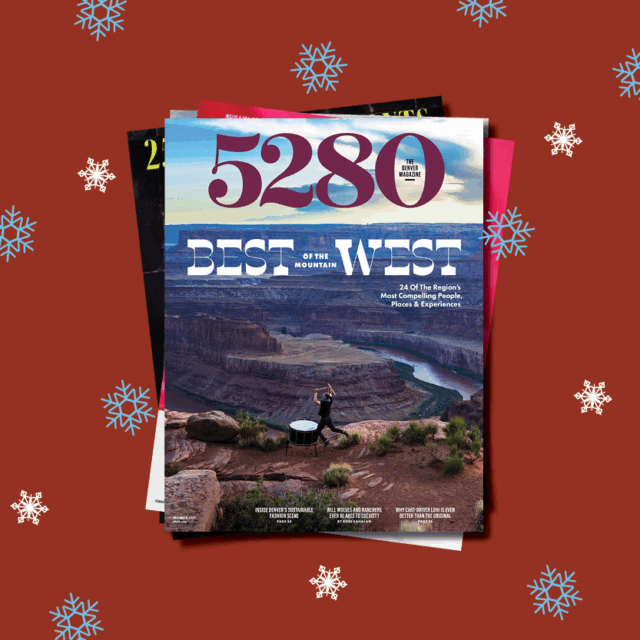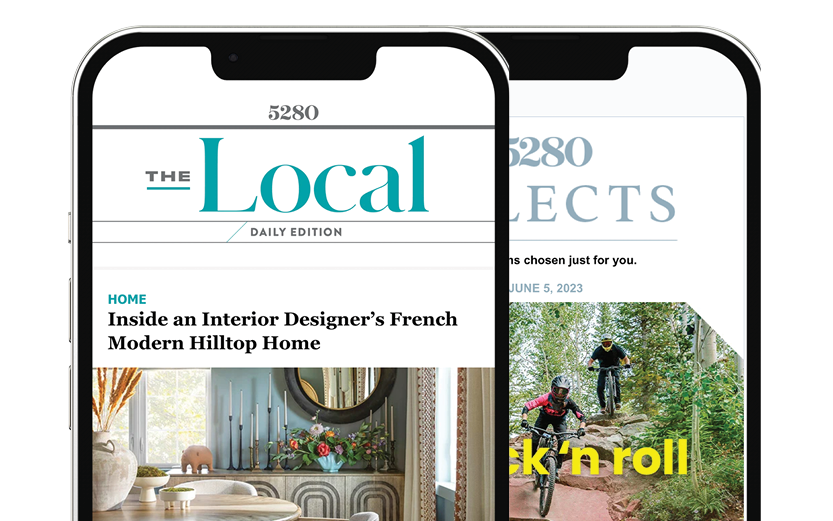The Local newsletter is your free, daily guide to life in Colorado. For locals, by locals.
You won’t find Paul Kirby’s signature at the bottom corner of his paintings. Instead, the colorful abstracts that line the walls of his Loveland studio (which you can take a virtual tour of here) are marked with “Dulcinea”—the 10-foot-by-10-foot robot that Kirby spent nine years building and the past two decades creating art with. Powered by seven motors and programmed with complex layers of coding, Dulcinea paints thousands of intricate brushstrokes on canvas with its flexible, human-wrist-like arm before washing its own paint brushes and powering down in the lower-left corner of its workspace, “home for her,” Kirby says.
Kirby and Dulcinea’s co-creations are a product of fusioneering, a term that the 75-year-old Air Force veteran, engineer, venture capitalist, and artist coined to describe the process of melding together two or more disparate passions into a whole new career field. This concept is the basis of Kirby’s debut book, The FUSE Pathway: How to Find and Lead a Fulfilling Life, which “promises a road map to design a life filled with creativity, purpose, and joy,” as noted by its inside cover. We caught up with Kirby to chat about the personal epiphanies that led him to fusioneering, how he landed on his robot’s name, and the new book (available April 1 on Amazon).

Editor’s note: The following conversation has been edited for length and clarity.

5280: When did you develop your passion for engineering?
Paul Kirby: It started as a little kid. I was an Army brat living in Austria, and I was always playing with my Lincoln Logs and Tinkertoys. Later, we were stationed in Copenhagen for four years, and, being shy and not knowing the language, I could entertain myself in my room. I eventually learned Danish and would go out and play soccer with the neighborhood kids and stuff, but the whole time growing up, I was always building things and designing things with my hands.
I pursued an engineering degree at University of California, Berkeley, then did four years in the Air Force for the latter part of Vietnam, and then I was accepted to Harvard Business School.
What made you want to combine your love of science with art?
In my second year at Harvard, I took a self-assessment [personality] test with 100 multiple choice questions. I got the results back and there were six criteria ranked from zero to 100. In the bottom quarter was social, religious, economic, and political. Way at the top was theoretical, which wasn’t a surprise, given my engineering background. And then just above the halfway point was aesthetic, which was a real surprise for me since I didn’t even know what “aesthetic” meant.
One of the three major epiphanies I’ve had in my life was while walking across this foot bridge on campus, on my way to a Sunday evening mass at St. Paul’s Cathedral, thinking, What do I do with “aesthetic” and “theoretical”? I said, I’ll put them together. I’ll combine my love of science, technology, and robotics with art—even though I didn’t know anything about art other than what you do in first or second grade. So that was the idea. I went on to graduate and got a job at Hewlett-Packard in Loveland. But the idea always just sat there in the back of my mind.
So, when did you finally decide to act on that idea?
In 1994, I went to a Leonardo da Vinci museum in Malmö, Sweden, with my lifelong Danish friend. We saw all these giant wooden replicas of da Vinci’s mechanical inventions, and this is the guy that painted two of the most famous paintings in the world. I walked out of there, thinking, What if da Vinci was alive today and combined his love of inventions and machines with art? I decided then, at 44 years old, that that’s what I wanted to do; that was the next epiphany. That’s what got me on this course for the last many, many years, happily pursuing what I call a “fusion path”—finding your passions and fusing them together into a vision. So I built this fully automated robot that paints paintings.
It took nine years to build your painting robot. What was that process like?
For any ambitious project, you really can’t forecast how long it’s going to take. I was taking art classes—mainly oil painting and sculpting—while I was building the robot. I was so overwhelmed and discouraged at first because there was so much I had to do. But one step at a time, it just kept growing and coming together. I built the wrist…and then later I added pneumatics to help grab the jars of paint to feed under the robot’s wrist, and then there’s so much programming involved. I didn’t know it was going to take nine or 10 years, but it didn’t really matter, because the whole time I was doing it, I loved what I was doing.
How did you land on the name for your robot?
It didn’t take me long to come up with Dulcinea. In Don Quixote, Dulcinea is a hard-working wench in a neighboring village, but [Quixote] sees her as a fair maiden. In my eyes, my robot is a fair maiden, a princess. In reality, she’s just hard working.

Do you have any favorite paintings that you and Dulcinea have made together?
While building Dulcinea, I made two rules: I would never touch up anything that she did, and I would never copy a photograph. Everything had to be original. I just fell in love with the whole process of creating art. Each painting has been a milestone in time, so I wouldn’t change my first painting at all because that was what I was able to do at that point, and it’s evolved from there. Each time I do a new painting, it’s usually a whole new direction—whatever I’m curious about or whatever fascinates me at the time. For example, one time I was at the Getty Museum in Los Angeles, in their impressionist room, and saw one of Monet’s Haystacks. It had glittering snow on the ground and I was just fascinated with that. So I thought, I want to do a pointillism painting. It’s got six colors of warm yellow, six colors of cool yellow, and six colors of warm and cool purple, going from light to dark. So 24 colors total. My robot worked three days nonstop to create it, and it ended up having like 35,000 brushstrokes.
Tell us about your new book, The FUSE Pathway. What made you want to write it?
I was a happy hermit in a hobbit hole, and then these darn kids show up. I had these at-risk high school kids come by my studio for a tour, and their intensity and sheer exhilaration and excitement [about the art and the robot] changed me forever—that was my third epiphany. I thought, I have a responsibility to share what I’ve done and excite and inspire others to follow their own dreams. So the fusioneering framework evolved from that. The book is broken into four parts that make up the acronym FUSE: F for Find, find your passion by fusing your interests; U for Upgrade, upgrade your skills to a new level that satisfies your vision; S for Start, you can get started right away or slowly phase into this new path; and E for Evolve, which, in my case, is always continuing to work on the next painting and always challenging myself to make it better.
I enjoyed it, but I’ve got to tell you, I don’t plan on writing anymore. I’d rather work on the next painting.










